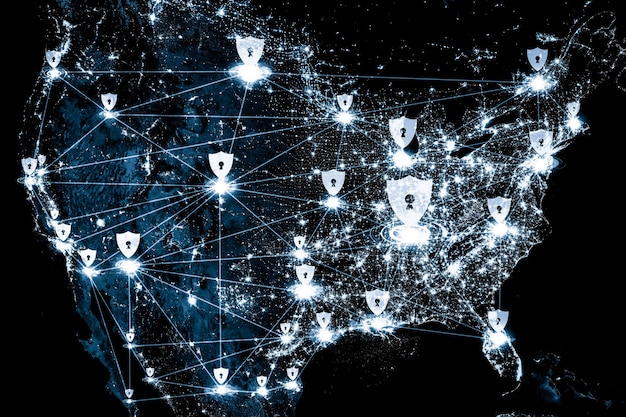Mexico Cybersecurity: Protecting US Data & Assets

Navigating Mexico’s cybersecurity landscape is crucial for US companies, requiring robust strategies to protect data and assets amidst evolving threats and a complex regulatory environment.
In an increasingly interconnected global economy, US companies operating in Mexico face unique challenges, particularly concerning cybersecurity. Understanding Mexico’s cybersecurity landscape: how US companies can protect their data and assets goes beyond mere compliance; it’s about business continuity and safeguarding sensitive information.
understanding Mexico’s cyber threat landscape
Mexico, as a major trading partner and investment destination for US companies, presents a complex and evolving cybersecurity environment. The digital transformation sweeping across industries brings efficiency and opportunity but also broadens the attack surface for malicious actors.
The nature of cyber threats in Mexico is diverse, ranging from state-sponsored attacks and organized crime to individual hackers aiming for financial gain or disruption. This multifaceted threat landscape necessitates a proactive and adaptive approach from US businesses.
prevalent cyber threat types
- Ransomware attacks: These continue to be a significant concern, encrypting critical data and demanding payment, often disrupting operations entirely.
- Phishing and social engineering: Human vulnerabilities are consistently exploited through deceptive emails, messages, and calls to gain access to systems or credentials.
- Insider threats: Disgruntled employees or those coerced often pose a substantial risk, whether intentional or unintentional, by exposing sensitive information or facilitating access.
- Supply chain attacks: Compromising trusted third-party vendors or software allows attackers to infiltrate target organizations indirectly, making detection challenging.
The sophistication of these attacks is constantly increasing, requiring companies to invest in advanced detection and prevention technologies.
Moreover, the motivations behind these attacks are varied, from financial extortion and intellectual property theft to espionage and geopolitical influence. Businesses must recognize that they are not just victims of random acts but potential targets within a larger, more calculated scheme.
Mexico’s rapid adoption of digital technologies in sectors like manufacturing, finance, and telecommunications creates fertile ground for cybercriminals. The lack of standardized cybersecurity protocols across all industries, coupled with varying levels of awareness, often leaves vulnerabilities exposed.
Therefore, a comprehensive understanding of these threats is the first step for US companies aiming to secure their operations and data in Mexico effectively.
key challenges and vulnerabilities for US companies
Operating in a foreign jurisdiction inherently introduces a new layer of complexity, and Mexico is no exception when it comes to cybersecurity. US companies often face unique challenges stemming from cultural differences, regulatory discrepancies, and local infrastructure peculiarities.
One primary challenge is the varying maturity levels of cybersecurity infrastructure and practices within Mexican organizations, including potential partners and suppliers. This disparity can create weak links in the overall security chain.
regulatory and legal complexities
Mexico’s legal framework for cybersecurity is fragmented, with data protection laws like the Federal Law on Protection of Personal Data Held by Private Parties (LFPDPPP) coexisting with other regulations that may not explicitly address cybercrime. This can lead to ambiguity regarding compliance and liability for US companies.
- Data localization: While not as stringent as in some countries, certain data categories may have specific handling requirements that differ from US norms.
- Incident reporting: The lack of a centralized, mandatory incident reporting scheme can make it difficult to understand the true scope of cyber threats, and may also complicate knowing to whom incidents should be reported.
Navigating these regulatory nuances is critical to avoid legal repercussions and maintain operational integrity. Companies must invest in legal expertise that understands both US and Mexican law.
Beyond regulations, the general cybersecurity awareness and training standards within the Mexican workforce can also differ significantly from those in the US. This necessitates tailored training programs for local employees to mitigate human risk factors.
Furthermore, the reliance on certain legacy systems or unpatched software in some Mexican businesses can present easy targets for attackers. US companies must conduct thorough due diligence on any local partners or acquisitions to identify and address these potential vulnerabilities before they are exploited.
strengthening your cyber defenses: best practices
Building a resilient cybersecurity posture in Mexico requires a multi-pronged strategy that addresses technological, human, and process-related aspects. Simply applying US-based security practices may not be sufficient due to the distinct local context.
The foundation of any robust defense strategy is a comprehensive risk assessment, specifically tailored to the Mexican operating environment. This assessment should identify critical assets, potential threats, and existing vulnerabilities.
implementing robust security measures
Technical controls are paramount, forming the backbone of your protection. These should be regularly updated and monitored to counter emerging threats.
- Multi-factor authentication (MFA): Mandate MFA for all systems, especially those accessing sensitive data or remote networks.
- Endpoint detection and response (EDR): Deploy EDR solutions on all devices to monitor for suspicious activities and respond to threats in real-time.
- Encryption: Encrypt all sensitive data, both in transit and at rest, to protect it from unauthorized access, even if systems are breached.
- Network segmentation: Isolate critical systems and data repositories from general networks to limit the lateral movement of attackers.
Beyond technology, employee training and awareness programs are crucial. A well-trained workforce acts as the first line of defense against social engineering and phishing attacks. These programs should be continuous, engaging, and localized to resonate with Mexican employees.

Regular penetration testing and vulnerability assessments, conducted by reputable third parties, can identify weaknesses before adversaries do. These assessments should span IT environments, operational technology (OT) systems, and supply chain integrations specific to Mexican operations.
Finally, a robust incident response plan, regularly tested through tabletop exercises, ensures that your company can effectively detect, respond to, and recover from cyberattacks with minimal disruption. This plan should include communication protocols for local authorities and stakeholders.
data protection and privacy regulations in Mexico
Compliance with data protection and privacy regulations is not merely a legal obligation but a cornerstone of trust for any business. In Mexico, the primary legislation addressing this is the Federal Law on Protection of Personal Data Held by Private Parties (LFPDPPP).
Understanding the nuances of LFPDPPP is vital for US companies handling personal data of Mexican citizens or residents. This law, while not as broad as GDPR, imparts significant responsibilities on data controllers and processors.
LFPDPPP essentials for US businesses
- Consent requirements: Companies must obtain explicit consent (or implied, depending on the data sensitivity) for the collection, use, and disclosure of personal data.
- Data subject rights (ARCO rights): Individuals have rights to Access, Rectify, Cancel, and Oppose the processing of their personal data. Companies must have mechanisms to fulfill these requests promptly.
- Data security obligations: The law mandates that data controllers implement administrative, physical, and technical security measures to protect personal data against damage, loss, alteration, destruction, or unauthorized use, access, or treatment.
- Data breach notification: While not as prescriptive as some international laws, prompt notification to affected data subjects and, in some cases, the Mexican National Institute for Transparency, Access to Information and Personal Data Protection (INAI) is expected in the event of a security breach.
US companies must ensure their data handling practices, from collection to storage and disposal, align with LFPDPPP. This includes revising privacy notices, implementing data processing agreements with third parties, and training personnel on data privacy best practices.
Furthermore, any cross-border data transfers from Mexico to the US must comply with LFPDPPP’s provisions, often requiring specific contractual clauses or other legal transfer mechanisms to ensure an adequate level of protection when data leaves Mexican territory.
Proactive engagement with legal counsel specializing in Mexican data privacy law is highly recommended to ensure full compliance and mitigate risks associated with data breaches or regulatory non-compliance.
building cyber resilience and incident response
Beyond prevention, a company’s ability to withstand and recover from a cyberattack defines its cyber resilience. In Mexico, where the threat landscape is active, a robust incident response and recovery plan is not just an advantage—it’s a necessity.
Developing an effective incident response framework involves planning, preparation, and practice. It ensures that when an incident occurs, the organization can respond swiftly and cohesively to minimize damage and disruption.
key components of an incident response plan
- Preparation: This stage involves establishing an incident response team, defining roles and responsibilities, and developing detailed procedures for various types of cyber incidents.
- Detection and analysis: Implementing tools and processes to identify potential security incidents early, including log monitoring, intrusion detection systems, and threat intelligence feeds. Once detected, thorough analysis is crucial to understand the scope and nature of the attack.
- Containment, eradication, and recovery: Proactive measures to stop the attack’s spread, remove the threat from systems, and restore affected services and data from secure backups.
- Post-incident activity: Learning from the incident through post-mortem analysis, updating security policies, improving defenses, and communicating lessons learned to relevant stakeholders.
Regular testing of the incident response plan through simulations and tabletop exercises is critical. These exercises should involve not only IT and cybersecurity teams but also legal, communications, and executive leadership to ensure a coordinated organizational response.

Establishing clear communication protocols, both internal and external, is also vital during an incident. This includes who communicates with law enforcement, regulators (where applicable), customers, and the media, especially considering the potential for reputational damage.
Finally, investing in cyber insurance tailored to cover incidents in Mexico can provide a financial safety net, though it should never replace robust security measures and a well-practiced incident response plan.
collaborating with local expertise and resources
Successfully navigating Mexico’s cybersecurity landscape requires more than just internal capabilities; it often necessitates strategic partnerships with local experts and leveraging available resources. Local insights can be invaluable in understanding the cultural, legal, and operational nuances.
Engaging with Mexican cybersecurity firms, legal advisors, and IT service providers who possess specific knowledge of the local context can significantly enhance a US company’s security posture.
finding the right partners
- Local cybersecurity consultants: These firms can offer specialized services, including penetration testing, vulnerability assessments, and compliance audits tailored to Mexican regulations and threat actors.
- Legal counsel specializing in Mexican law: Essential for navigating data privacy laws, incident reporting requirements, and contract negotiations with local vendors.
- Managed Security Service Providers (MSSPs): For companies without extensive in-house cybersecurity teams, MSSPs in Mexico can provide 24/7 monitoring, threat detection, and incident response.
- Industry associations: Engaging with Mexican industry associations can provide networking opportunities, share best practices, and offer insights into emerging local threats.
Furthermore, staying informed about local government initiatives and public-private partnerships aimed at improving cybersecurity nationwide can provide crucial context and potential opportunities for collaboration.
Building strong relationships with local law enforcement and regulatory bodies, where appropriate and advisable, can also be beneficial in the event of a significant cyber incident.
The value of local expertise lies not just in technical proficiency but also in cultural understanding. They can help bridge communication gaps, adapt strategies to local business practices, and ensure that security measures are implemented effectively within the Mexican operational context.
Ultimately, a collaborative approach that combines a US company’s global expertise with specialized local knowledge creates a more resilient and adaptable cybersecurity framework.
| Key Point | Brief Description |
|---|---|
| 🛡️ Threat Landscape | Diverse cyber threats from ransomware to sophisticated phishing target US firms in Mexico. |
| ⚖️ Regulatory Compliance | Navigating Mexico’s LFPDPPP and fluid reporting standards is crucial for data privacy. |
| ⚙️ Robust Defenses | Implement MFA, EDR, encryption, and network segmentation adapted to local context. |
| 🤝 Local Collaboration | Partnering with Mexican cybersecurity firms and legal counsel offers invaluable local insights. |
frequently asked questions about cybersecurity in Mexico
US companies in Mexico frequently encounter ransomware attacks, sophisticated phishing schemes, and insider threats. Organized cybercrime also targets businesses for financial gain and data theft, often exploiting vulnerabilities in supply chains and third-party vendors. The diverse motivations from financial to corporate espionage make the threat landscape particularly complex.
The LFPDPPP requires US businesses to obtain explicit consent for data processing, grant data subjects ARCO rights (Access, Rectification, Cancellation, Opposition), and implement robust security measures. Cross-border data transfers to the US must also adhere to specific legal mechanisms, ensuring data protection even outside Mexico’s borders.
Key security measures include mandating multi-factor authentication (MFA), deploying endpoint detection and response (EDR) solutions, encrypting all sensitive data, and segmenting networks. Regular employee training on cybersecurity awareness, tailored to local contexts, and continuous vulnerability assessments are also crucial for a strong defense.
Building cyber resilience is critical in Mexico due to the active threat landscape. It ensures companies can effectively withstand, respond to, and quickly recover from cyberattacks, minimizing downtime and financial loss. A well-practiced incident response plan, covering preparation, detection, containment, and post-incident analysis, is fundamental to this resilience.
Local partnerships with Mexican cybersecurity consultants, legal counsel, and MSSPs are crucial. These partners provide invaluable insights into cultural nuances, regulatory specificities, and local threat actors, helping US companies tailor security strategies effectively. This collaboration bridges knowledge gaps, strengthens defenses, and ensures compliance within the Mexican operating environment.
conclusion
Securing operations for US companies in Mexico is an intricate but unavoidable aspect of doing business in a digitally connected world. The evolving cyber threat landscape, coupled with specific regulatory and cultural nuances, demands a strategic and adaptable approach. By understanding the prevalent threats, addressing key vulnerabilities, implementing robust security measures, ensuring data privacy compliance, and fostering strong cyber resilience through effective incident response, companies can significantly protect their data and assets. Moreover, leveraging local expertise and forging strategic partnerships are vital for navigating the Mexican cybersecurity ecosystem effectively. Ultimately, a proactive, comprehensive, and localized cybersecurity strategy is not just a defensive measure, but a critical enabler for sustainable growth and success in the Mexican market.





